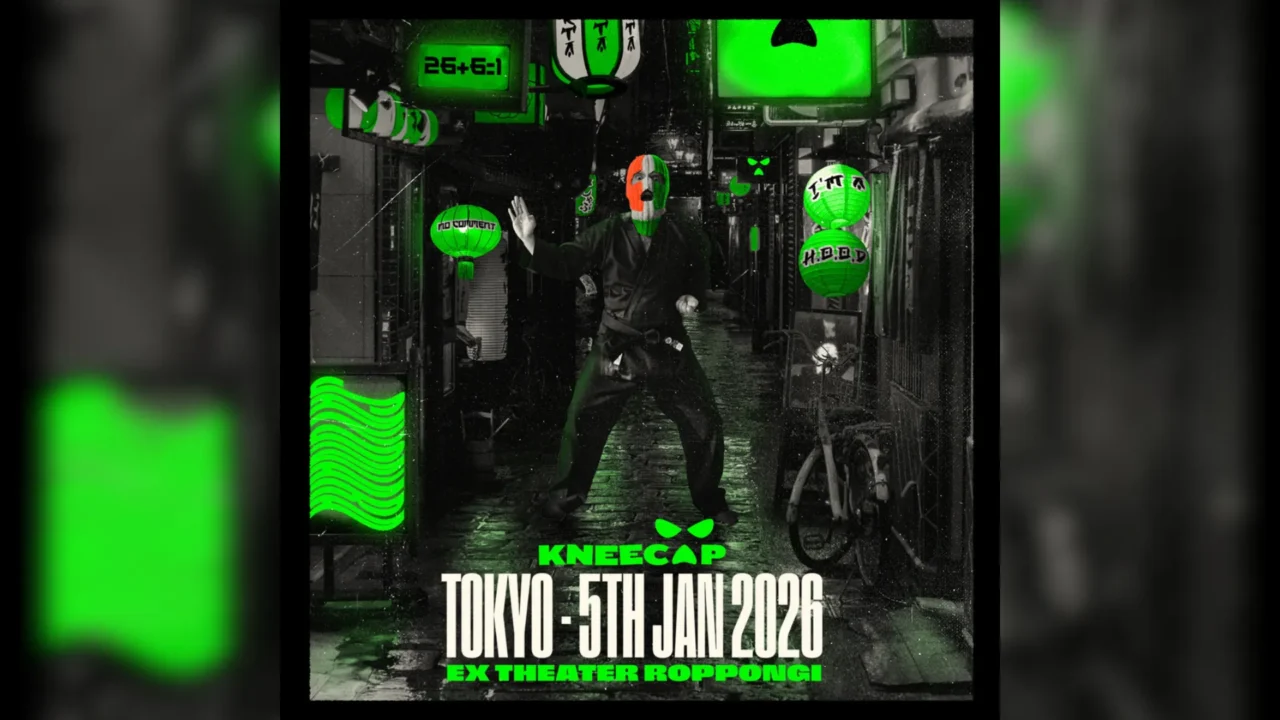Lee Heemoon is a singer of “Gyeonggi Minyo,” which is designated as an intangible cultural asset in Korea. Although he is an artist who is a direct heir to traditional music, in his own projects he combines folk songs with rock, jazz, and a variety of other genres to create a modern sound. He is a pioneer in the Korean music scene as a comprehensive artist who also creates and directs the visuals that match the concept of each work. However, most of you probably know him for the first time here. We have only known him for a short time, but the more we learn about him, the more new expressions appear, and each time we see him, we feel as if we are encountering Lee Lee Heemoon for the first time.
Born to a mother who was a master of Gyeonggi folk songs and a father who was a Korean living in Japan, Lee began his career in folk music at the surprisingly tender age of 27. Heemoon has many connections to Japan, including having lived in Tokyo with his mother when he was a child and having studied at a technical college in Tokyo. In “Gangnam Oasis,” released at the end of last year, he tells the story of his family before he started singing folk songs. She sings about Ran-chan, Kimura-san, Osaka, and Hitomebore…… memories of her mother, while also singing in Japanese.
“GANGNAM OASIS” will be performed in Tokyo. On the day of the performance, the three-member jam band CADEJO will join the audience in a special performance to express this world view. In preparation for the performance, we went to Gangnam, Seoul, where he was born and raised, to interview Lee Heemoon about his journey and the style he has built. It has been about 20 years since he decided to pursue a career in folk music. We hope that those of us who live in neighboring countries can share in the happiness of having met the artist Lee Heemoon.
INDEX
Heemoon who studied in Japan and aspired to be a music video director, started his career in folk music at the age of 27.
– I heard that you had studied in Japan.
Heemoon: Yes, I did. Before that, I went to college in Korea, but I couldn’t adjust. After that, I joined an entertainment agency to become a pop singer and lived as a trainee, but that didn’t work out either. At that time, I felt that the old Korean entertainment system was not good enough to begin with, so I decided to study in Japan, which was more advanced than Korea at the time, and which I was familiar with because it was my father’s second hometown. At first, I wanted to study artist management, but there was no department for it. While attending a Japanese language school and thinking about what to do, I saw Madonna’s “Frozen” music video and was impressed by the director, Chris Cunningham. I was so impressed (laughs). (I was so impressed.) Then I decided that I wanted to become a music video director, and I enrolled in the promotional video course at Toho Gakuen College of Music.

Lee Heemoon was born in 1976 in Seoul, Korea. Gyeonggi folk singer. Completed Gyeonggi Folk Song Course No. 57 of the National Intangible Cultural Foundation. Representative of Lee Heemoon Company. Mother is Koh Juran, mother of a folk singer. Became a student of Lee Chun-hee and became a folk singer. As an inheritor of traditional music (Gugak) and a pioneer in the Korean music world, she continues to express herself in her original style by fusing various musical genres with folk music motifs, and has participated in the OST for the drama “My Dear Mister” starring IU and the movie “Chansil-san has many blessings. She has received numerous awards, including the KBS Folk Music Grand Prix Folk Song Award (2014) and the “Young Artist of the Moment Award” (2015) for her contributions to cultural and artistic development.
http://leeheemoon.com/
– I thought you were studying singing under the influence of your mother, who is a folk singer. Did you continue to work in Japan after graduation?
Heemoon: After graduation, I returned to Korea and worked for a freelance director as an assistant director of music videos. On a day off from work, there happened to be a performance by a folk singer who was my mother’s junior, so we went to see it together. There, I met Lee Chun-hee, a folk singer who used to come to our house when I was a child, for the first time in a long time.
– So the mother, the teacher, and the three people you used to spend a lot of time with when you were young came together.
Heemoon: Yes, that’s right. For the first time since I became an adult. I was unconsciously humming while watching the performance, and the teacher said to me, “Heemoon, do you know folk songs? Don’t you want to sing?” She asked me. I had been listening to my mother’s songs ever since I was born, and I grew up in an environment where there were many singers around who were her colleagues, but no one asked me that at the time. When I was a child, folk singers were almost exclusively women, so the idea of “having my son sing folk songs” would not have occurred to me. But my teacher knew that I grew up listening to folk songs, so maybe she thought there was some potential.
– I am sure that there was still a sense of familiarity in my body.
Heemoon: Yes, I did. That said, many people start folk music as children, and I thought it might be too late for me, in my mid-twenties, to take it up, but I liked singing, and I thought it would be okay to learn on my days off, so I decided to give it a shot.
INDEX
The conflict and change of heart before deciding to concentrate on traditional music in earnest
– You didn’t decide to enter the world of folk music in earnest from the beginning, did you?
Heemoon: When I went to my teacher’s office later, he told me to sing a song that I liked. I sang a song called “Chang Arirang.” It didn’t have a specific rhythm, and I sang it in time with my breathing. It was difficult, but I liked it, so I sang it even if I was not very good at it, and my teacher heard it and said, “Heemoon, you have to do folk songs. I think those words were a big trigger for me to enter the world of folk songs.
– That was the moment when your teacher sensed the talent hidden inside you. But you were still working as an assistant director for music videos at that time, weren’t you?
Heemoon: Yes, I did. After going to the teacher’s office, I practiced intensively for about three months and then entered a contest and came in second place. My teacher said, “Heemoon, if you want to be a professional folk singer, you need to study folk music in college to be recognized. I still wanted to be a music video director as far as I was concerned, but when he said that, I thought that going to school somehow wasn’t a bad idea (laughs).

– Somehow! (laughs) So, you end up entering the folk music department of the Seoul Institute of the Arts.
Heemoon: At that time, if you had won a contest, you could get in just by taking a practical test. I was lucky, wasn’t I? At first I was planning to attend college while continuing to work on music video production, but the classes in the folk music department were so rigorous that we practiced all day long, so there was no time to work. If I had just taken the classes as I went along, I might have been able to balance both, but I was in my late 20s and had decided to enroll in the program on my own, so wouldn’t it be silly if I didn’t work hard? I thought. I thought it was the right time to choose between continuing to work or learning folk music in earnest.
Also, in 2004, the budget for music videos suddenly decreased in Korea due to the change to downloading music by MP3 and the lack of CD sales. In response to the music industry, which is rapidly changing with the times, I thought that traditional music is a world where the value of a song is refined by continuing to sing it over the years. I was halfway convincing myself to quit my job and concentrate on school (laugh). Since then, I have been practicing hard.

INDEX
To find the answer to why I continue to play traditional music in this day and age
– I think you became a professional through days of training, but you must have had a lot of difficulties in the world of folk music, where women are the main performers.
Heemoon: Since the base of folk music is a woman’s voice, it is all I can do to reach the right pitch with a man’s voice. I can’t even use my own singing technique freely. It was also very difficult to sing in a performance with only female singers, so I decided to try it alone. Since I wanted to sing at my own pitch, I decided to do a solo performance once a year.
– At that time, were you singing traditional folk songs instead of the multi-genre music style you are using now?
Heemoon: Yes, I did. But I wanted to make it new little by little. I arranged my own traditional costumes, and for the performance, I had a Korean dance artist direct me and I danced with a Korean dance team. I thought it would be more fun to make the stage a comprehensive art form, not just a song.
Especially with folk songs, there are many old words that cannot be understood only by singing, so we added another way of expression to convey the content. After meeting with this Butoh team, we changed the arrangement and performance of the songs a little bit in a modern way, making traditional music new. It seems that people who are not specialists in this field thought, “That’s no change,” but it was a very big change for me.

– So that’s how you built the base of your current expression.
Heemoon: Also, meeting contemporary dance teacher Ahn Eun-Me (Ahn Eun-Me) was a big deal. I auditioned for his stage and was invited to participate in his contemporary dance productions in 2006, touring Europe once a year for 10 years. The musician in charge of music for those performances was Jang Young-gyu (張領gyu), who later worked with me in SsingSsing. It was around this time that the foundation for my own musical activities was laid, and I started producing my own works and later SsingSsing in 2015.
– SsingSsing became the first Asian singer to appear on NPR’s “Tiny Desk Concert,” a well-known YouTube program, which drew worldwide attention. How is your motivation to evolve your expression based on traditional culture and folk songs rooted in your mind, Heemoon?
Heemoon: I have a great desire to sing folk songs and to have many people listen to them. While I was working on my own activities, somewhere in the back of my mind I was thinking, “This is not going to happen,” and I think I was looking for ways to get more people to come and see my performances. On the other hand, when I started to add modern musical arrangements and a wider range of expression in this way, I felt that it was wonderful to sing songs that have been passed down from generation to generation without changing them in any way, and I also think that this is the real folk music.
– What made you feel that way?
Heemoon: While I was working on SsingSsing, I also continued to make works in which I sang folk songs in order to find an answer to the question of why I continue to do traditional music in this day and age. I think I was able to realize this because I was balancing two opposing forms of expression.
Later, I created a trilogy called “Kipunsarang” (‘Deep Temple Hall Love’ Series) with an art artist. I made this work while researching the roots of the folk songs I was singing again, and I created each part of the trilogy in a different era, and I included a song about my mother, a folk singer. I wanted to know what kind of life my mother led after she started singing folk songs. I thought that if I told the story of my mother, the history of female minyo singers would be revealed. It may be natural, but it is not easy to talk about other people’s stories. But I can tell my own story with confidence. Confidence that I know my own story best.

INDEX
The “lack” felt in his latest work. Telling my own story is helping me heal myself.
In “GANGNAM OASIS” released last year, you wrote the lyrics as your own story based on what you heard from your mother. When did you start thinking about the idea for this piece?
Heemoon: After I finished making “Kipunsarang,” I was thinking about what story I should tell after that. With “Kipunsarang,” I expressed myself about traditional culture in a straightforward manner and solved some of the questions I had been having since I started doing folk songs. So next time, I thought that if I made a work about the time before I started doing folk songs, I might have a better understanding of who I am now. To do so, I thought I needed a new way of expression and new songs that I had never written before, so I teamed up with the band CADEJO to create a melody based on a folk song motif and wrote the lyrics myself for the first time.
– How did you go about writing the lyrics to the song, which are based on an episode of your late father?
Heemoon: The artist with whom I worked on “Kipsarang” interviewed my mother, and I transcribed the interview and wrote the lyrics. I thought it would be better if people who don’t know us heard it, since there are probably many things we can’t tell our families.

– How did you feel when you read the interview?
Heemoon: There were stories that I already knew, but there were also stories that I wouldn’t have been able to tell my son, so I read the interview thinking, “Oh, I didn’t know that” (laughs). There were only a few memories of my father that remained in me.
– So there was a picture of your father that you didn’t know about?
Heemoon: I realized that I had been under the illusion that my mother had told me that my father was this kind of person, and that this was my own memory of him. So, the father I remember is the father in my mother’s mind. I had very few memories of my own father, partly because we were together for such a short period of time. So I wrote the lyrics to “GANGNAM OASIS” based on my mother’s story, and I put my own thoughts and feelings about my father into the lyrics. I said, “This is wrong, that is not right” (laughs). That’s what I’m singing now.
– What does “GANGNAM OASIS” mean to you when you actually perform it?
Heemoon: Lack, I guess.
– How do you think that “lack” will change as you continue to sing?
Heemoon: Maybe it is the feeling of healing oneself. By telling my story to someone and having them listen to it, I heal myself.


INDEX
The power of the voice itself is the most attractive thing.
– “GANGNAM OASIS” is not complete, is it?
Heemoon: Yes, it is. I am planning to make “Gangnam Oasis” into a trilogy, the second one being the story from junior high school to high school. There were two people who were like my whole life back then: my grandmother, who protected me, and Min Hae Kyung (Min Hae Kyung), a singer. I was a big fan of Min Hae Kyung and followed her around. She is a Kang Nam nerd (laughs). The story of the two of them will be the theme of the film.
– Kangnam geek (laughs). Can you tell us a little bit about Min Hye-gyeong?
Heemoon: She is a female artist from the 1980s, and my favorite part is everything about her. She’s an idol or a diva. She was active in Japan at the time.
– I see. The singing ability of idols back then was tremendous, wasn’t it?
Heemoon: Yes, they were. Min Hye Kyung also had great singing ability and she had her own voice. I think it is the same in Japan, but many singers in the 1980s had their own voices. Even if there is no video, if you listen to their voices, you can easily recognize them as “this is a song by Momoe Yamaguchi, this is a song by Seiko Matsuda,” and so on.

– You are another singer with an original voice.
Heemoon: Of course I learned the basics from my teachers, but my singing style changed as I went through various activities in my own way, and I created my own voice. I think it is attractive for singers whose voices can be instantly recognized just by listening to them.
– I’m excited to hear your voice at the Tokyo concert and to hear the session with your band, CADEJO, a jam band based on funk and soul but pursuing improvisation.
Heemoon: Thank you very much. Most of the lyrics are in Korean, so it may be difficult to convey everything, but I think you will enjoy the songs themselves, including the unique singing technique, which is a folk song technique. As for the rest, well, there is a very cool CADEJO performance, so I think that’s enough (laughs). I hope everyone will have a great time.


Lee Heemoon+CADEJO 『 GANGNAM OASIS in Tokyo』

Date: Thursday, June 1, 2023 Venue: Aoyama, Tsukimiru Kimi Omou
Time: Doors open 18:30 Concert begins 19:00 (all standing)
Performer: Lee Heemoon+CADEJO
Guest: VIDEOTAPEMUSIC
members Emerson Kitamura (Key) Izumi Matsui (Per) Yuichi Ushioda (Gt) mmm(Flute, Vo)
Tickets: ¥6,000 advance ¥6,500 at the door (+1 drink order for both / handbook included)
Contact : Aoyama Tsukimiru Kimi Omou
























